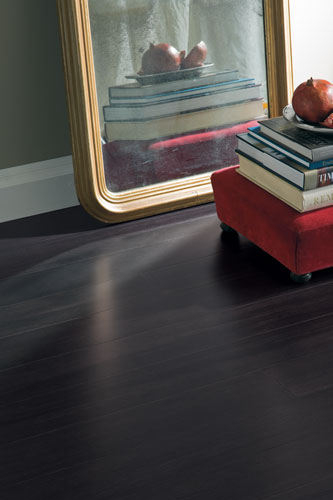 With all the interest in environmental friendliness and reducing carbon footprints, bamboo continues to be one of the more popular niche products. And because bamboo is an alternative flooring “where the grass is greener” environmentally speaking, producers are ensuring retailers know how to sell the product effectively and are aware of the category’s profit potential.
With all the interest in environmental friendliness and reducing carbon footprints, bamboo continues to be one of the more popular niche products. And because bamboo is an alternative flooring “where the grass is greener” environmentally speaking, producers are ensuring retailers know how to sell the product effectively and are aware of the category’s profit potential.
As a pioneer in the bamboo flooring industry since 1994, Teragren has championed strict environmental standards, said Ann Knight, executive vice president/global brand director. “We have worked with the U.S. Green Building Council (USGBC) to promote its LEED (Leadership in Energy and Environmental Design) Green Building Rating System, which has become the national standard.”
Bamboo is a rapidly renewable resource and regrows from the same root stalk in a 10-year harvest cycle or less. “Teragren Optimum 5.5 Moso bamboo is harvested at maturity between five-and-a-half and six years to ensure product quality.”
According to Knight, for those retailers either just getting involved with bamboo or wanting to learn how to become more effective at selling it, questions they should be asking suppliers include:
1. When was the bamboo harvested?
2. Which specie was used?
3. How hard is it on the Janka ball test?
4. Is the bamboo flooring coming from a reputable manufacturer, or an importer or trading house purchasing from any factory or multiple factories based primarily on the lowest price? 5. How truly environmentally friendly is the flooring?
6. How does the flooring affect indoor air quality? and
7. Will the product offer lasting value?
Regarding the recent rules affecting logging and the hardwood industry, she said it is business as usual for the company as it was already in compliance. “The Lacey Act has actually increased sales of Teragren products, especially since the introduction of our Synergy strand bamboo flooring line, which outperforms many exotic hardwoods in durability and beauty. And our products were also manufactured to CARB Phase I and II standards before they became law. These regulations haven’t deterred how we do business.”
Stressing the benefits
The selling points or attributes bamboo offers are numerous, and, according to manufacturers, something on which retailers need to educate themselves. At USFloors, where the company’s most recent innovation in the bamboo category has been the development of its Corboo hybrid, strand woven product, “probably the biggest improvement we’ve made is with regard to indoor air quality of our bamboo products,” said Gary Keeble, marketing manager. “All of our Natural Bamboo floors with our proprietary Endura AR finish are indoor air quality certified by the Greenguard Children & Schools standard. We’re also about to cover the roof of our manufacturing facility with a new 365 kW solar photovoltaic array that will generate significantly more energy than the 31.5 kW system it is replacing.”
The mill’s bamboo floors have always been in compliance with Lacey and CARB regulations, Keeble added. “Our Greenguard Children & Schools certification gives retailers and consumers added assurance that Natural Bamboo floors are not going to adversely effect the indoor air quality of their home.”
At Mohawk, one of the mill’s latest sustainable products is the introduction of strand woven bamboo, noted Roger Farabee, senior vice president of marketing. “Our strand woven bamboo styles have been tested to be twice as hard as domestic oak, making them applicable for both residential and commercial applications. Mohawk products are manufactured using all parts of the bamboo stalk for optimum green benefits, and they meet European E-1 Standards for low formaldehyde emissions. Our bamboo products can also contribute LEED points to an installation.”
-Louis Iannaco
